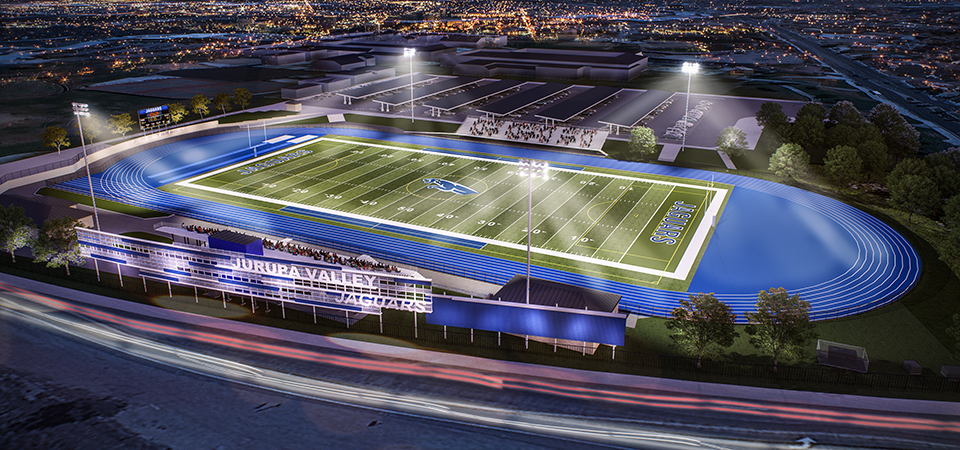By Angel Hosband, Managing Principal, HMC Architects; Trenton Hansen Ph.D., Assistant Superintendent, Planning and Development, Jurupa Unified School District; Brian Meyers, LEED AP BD+C, Principal, HMC Architects
Athletic programs and extracurricular opportunities continue to distinguish schools from each other, draw students in, and build a sense of community. In recent years, however, with a need to prioritize spending, some school districts swept deferred maintenance dollars into general funds and, as water restrictions were implemented across the state and costs to maintain athletics facilities increased, many fields fell into disrepair. The consequences have been more injuries, fewer practice days, and a general assumption that school districts are unwilling to invest in athletic programs and, by extension, their student athletes. In contrast, the school districts that invested in their athletic facilities over the last few years have seen a tremendous increase in student morale and health, growth in campus culture, and excitement within their communities.
Jurupa Unified School District
Jurupa Unified School District (JUSD) was looking to create a 21st century campus, conserve water, and create excitement within the community. As a large residential development took form adjacent to Jurupa Valley High School, the District realized that a revitalized stadium could have a positive impact on both its students and its community. JUSD believed that providing state-of-the-art athletic facilities would increase their students’ sense of community and belonging, demonstrate the District’s commitment to them, and allow Jurupa Valley High School to have a real presence within the community.
How They Did It
JUSD utilized developer fees and took advantage of local grant programs totaling $200,000 to supplement the project and bring its vision to life. Staff and students agree that the stadium has had a positive impact on the campus and has rekindled the positive culture that staff and students experience on campus. According to Principal Kimberly Corbin, “the amazing stadium upgrades have brought a new sense of pride and commitment to our school and community.” This sentiment is echoed by a student athlete, who adds “the stadium has helped the team work harder so that we can represent our school with pride on our new field.”
Sacramento City Unified School District
In northern California, the maintenance staff at Sacramento City Unified School District’s (SCUSD) John F. Kennedy High School (JFK) used to spend most of their time infilling gopher holes on game days, hoping the referees would allow play on the field. Injuries were commonplace, practice times were limited, and overall student participation in athletics was low. Not surprisingly, the football team was also suffering through a three-year losing streak.
How They Did It
In 2012, voters passed Measure R and the renovation of JFK’s stadium was one of the projects to be executed. The District wanted to replace the gopher-ridden field with an all-weather track and field hoping to reduce some maintenance costs. As it turns out, the student athletes were the real winners. Field-induced injuries dropped, enabling student athletes to stay healthy for the entire season. And the all-weather field can be used rain or shine, creating a more consistent practice schedule regardless of weather.
JFK’s Athletic Director Marcos Pineda shared, “the stadium brings positive attention to our programs, showcasing the fact we value our student athletes and their experience. For some who may have been deciding between our campus and others, this may have been the tipping point in choosing to attend Kennedy.” He added “the facility helped both in recruiting quality coaches and in retaining the quality coaches already on staff.”
In the season following the stadium grand opening, the football team ended their losing streak with a big win, finished the 2014 season with four wins, and made it to the playoffs the following season—a feat that hadn’t been accomplished since 1990.

